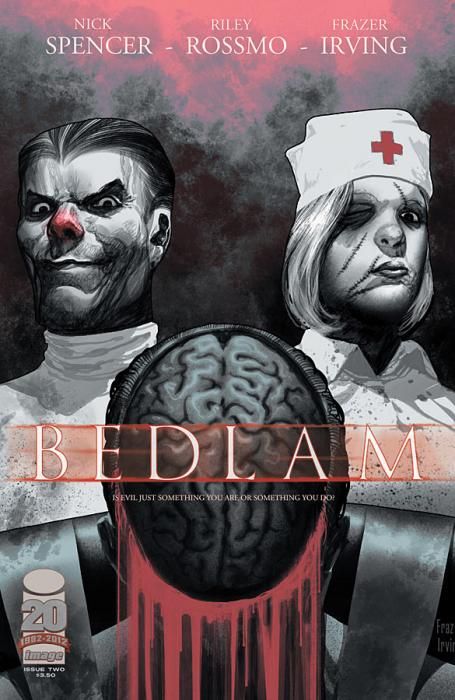"Bedlam" #2 by Nick Spencer and Riley Rossmo opens with two new characters, and their mundane encounter twists dramatically into a disturbing, over-the-top scene before turning to pick up shortly after Fillmore Press' outing at the end of "Bedlam" #1. It's powerful beginning that leads the reader into darkness, both psychologically and into the greater mystery of what these events are about.
Spencer and Rossmo's narrative approach in "Bedlam" #2 is cinematic or TV episode-like, and this feeling is reinforced by the panoramic title page dropping in between the two scenes. Rossmo uses camera angles like a horror-movie director, first obscuring the reader's view for two pages and drawing out suspense, then revealing a tableau drawn from a low-angle point of view, working to make the reader feel vulnerable and the subject even more threatening. The specific verbal and visual details are unexpected, fascinating and gruesome. Spencer and Rossmo have succeeded in evoking that sick fascination that accompanies a conflicted desire to look more and look away at the same time.
Rossmo splices Press' homeward journey with a feverish nightmare sequence, mixing memories with dream imagery. His choice to include vermin in the surreal double-page spread has symbolic significance and emphasizes the atmosphere of pollution and violation. Also, Rossmo's deliberately messy line works well for the dirty, dark city and the murky ethical world of "Bedlam." Even the people on the traditionally "good" side, such as doctors and police, already display a dangerous amount of self-righteousness mixed in with vanity and arrogance. These flaws seem like nothing, but they are terrifying in the greater context of the use and abuse of power.
I am disappointed that Spencer didn't choose to let readers directly listen in on Fillmore Press' epic phone conversation with the police informant's line. It was likely Press' first contact with the police since his rampage as Madder Red, and the potential for suspense and hilarity was immense. Fragments of the conversation are divulged to readers in retrospect, but the impact of the humor and the dialogue are diluted by temporal and visceral distance.
"Bedlam" #2 feels looser in structure than the debut issue, and it has a sandwich-like construction. First, there's a large slice of action, then a slower-paced, lighter-toned filling, and then a thin slice of rapid plot advancement and another does of shock at the end. Spencer also paints with a slightly wider brush, filling in many other major inhabitants and key players in the city.
Fillmore Press still feels modeled on the mythic archetype of a highly sensitive, highly intelligent killer, but he is developing distinctive features beyond the obvious comparisons to The Joker or Dexter. The characterization-driven middle passage of "Bedlam" #2 is excellent, revealing backstory through a creepy and funny "come to Jesus" conversation between Press and his "doctor." They make for an odd couple, and the scene has a bizarre lightness and humor due to Spencer's entrancing back-and-forth dialogue for them. Like Press, the doctor has an exaggerated speech rhythms and a theatrical, precise way of laying out his words. Rossmo's facial expressions and body language further emphasize their odd relationship and both characters' offbeat wit and creepy charm. They capture that essential feeling of "Bedlam" because they are at once repulsive and attractive, vulnerable and monstrous.
The biggest danger "Bedlam" faces is that its characters will be overwhelmed by Spencer's greater concept, but "Bedlam" #2 succeeds in opening up the innards of several characters at once, and their collective minds are the real voice of the title, more than Madder Red alone. Events seen and unseen in "Bedlam" #2 are like a half-unfolded fan, laid over a further darkness that draws inexorably and irresistibly nearer.

